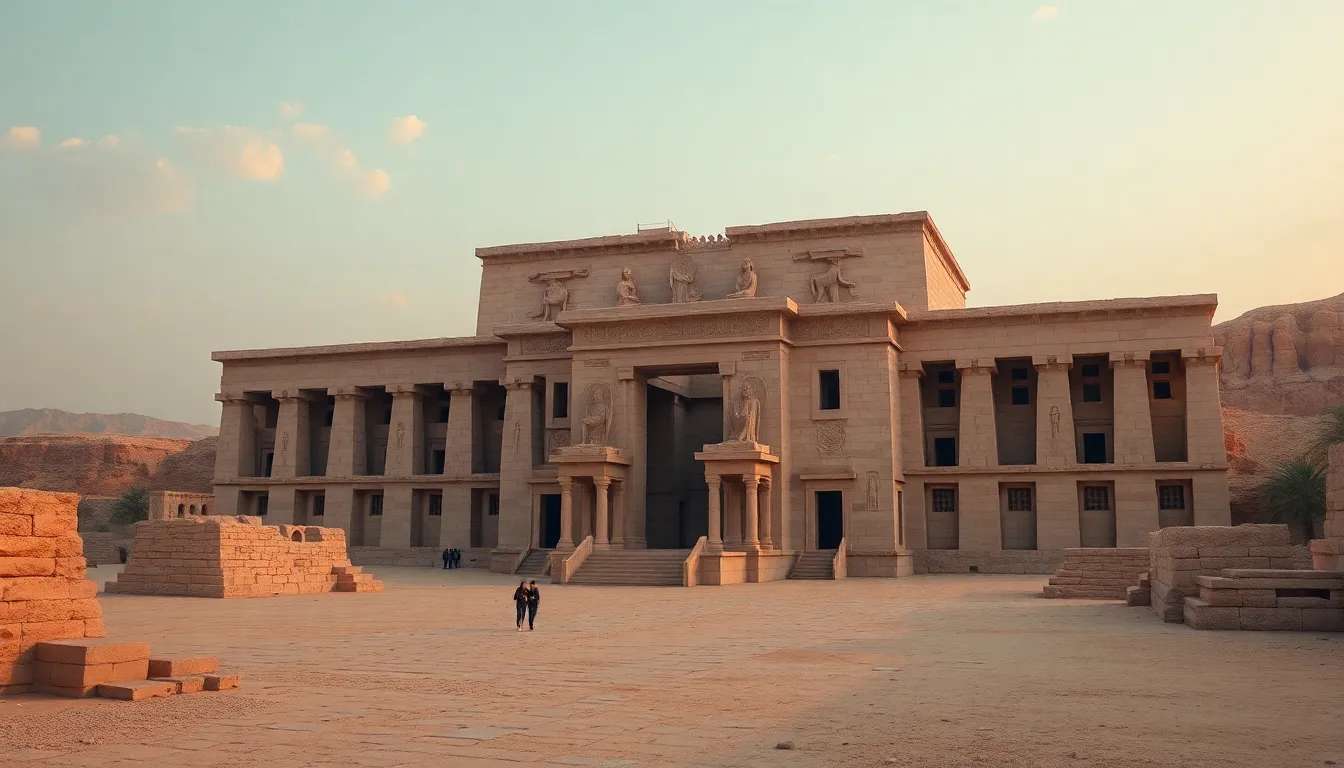The Sacred Geography of the Temple of Anubis
I. Introduction
Anubis, the ancient Egyptian god associated with mummification and the afterlife, holds a significant place in the pantheon of Egyptian mythology. Depicted as a jackal or a man with a jackal’s head, Anubis was revered as the protector of the dead and a guide to the underworld. His influence extended beyond mere symbolism, permeating the very fabric of ancient Egyptian religious practices.
In this context, the sacred geography surrounding the Temple of Anubis becomes a focal point of understanding how the ancient Egyptians engaged with their beliefs. Sacred geography refers to the specific spaces that hold spiritual significance, shaping religious experiences and practices. This article aims to explore the multifaceted aspects of the Temple of Anubis, examining its historical context, architectural features, and the broader landscape that contributes to its sanctity.
II. Historical Context of the Temple of Anubis
The Temple of Anubis has its origins rooted in the early dynastic period of Egypt, with construction believed to have started around 2500 BCE. Located near the necropolis of Saqqara, this temple served as a central place of worship for those seeking guidance in the afterlife. The ancient Egyptians believed that Anubis played a crucial role in the process of mummification and the weighing of the heart ceremony, wherein the deceased’s heart was weighed against the feather of Ma’at, symbolizing truth and justice.
Throughout history, the temple witnessed numerous key events, including:
- Royal funerals and burial rites conducted in honor of the deceased.
- Major religious festivals celebrating Anubis and the afterlife.
- Renovations and expansions during the Middle and New Kingdoms, reflecting the evolving practices and beliefs surrounding death and the afterlife.
III. Architectural Features of the Temple
The architectural design of the Temple of Anubis is steeped in symbolism, reflecting the beliefs and values of ancient Egyptian society. The temple features several design elements, including:
- Hieroglyphic Inscriptions: Walls adorned with inscriptions detailing Anubis’s role and the rituals performed within the temple.
- Pillars and Columns: Tall, majestic columns often shaped like papyrus plants, symbolizing rebirth and regeneration.
- Statues of Anubis: Iconic statues positioned throughout the temple, serving as focal points for worshippers.
The layout of the temple follows a specific orientation, typically aligned with the cardinal points, which was essential in ancient Egyptian architecture. This alignment was thought to facilitate the connection between the earthly realm and the divine.
Construction materials, such as sandstone and limestone, were not only practical choices but also symbolically significant. The use of these materials emphasized the permanence of the temple and its role as a sacred space intended for eternity.
IV. Sacred Spaces within the Temple
Within the Temple of Anubis, various sacred spaces served distinct purposes, each contributing to the overall religious experience:
- The Inner Sanctuary: This area was the most sacred, housing the primary statue of Anubis. It was here that priests performed the most important rituals.
- Ritual Spaces: Designated areas for performing specific rites, including the preparation of the deceased and offerings to Anubis.
- Burial Chambers and Tombs: Often connected to the temple, these spaces reinforced the association between Anubis and the afterlife, serving as resting places for the dead.
V. The Surrounding Landscape and its Symbolism
The geographic location of the Temple of Anubis played a crucial role in its sanctity. Situated near the Nile and the expansive desert, the temple was positioned within a landscape that held deep symbolic significance:
- Nile River: The lifeblood of ancient Egypt, the Nile represented fertility and the cyclical nature of life and death.
- Desert: The arid landscape symbolized the journey to the afterlife, with its harshness representing the trials faced by the soul.
These natural features not only enhanced the temple’s sacredness but also influenced the rituals and beliefs surrounding death and the afterlife.
VI. Ritual Practices Associated with the Temple of Anubis
The Temple of Anubis was central to various ritual practices integral to ancient Egyptian religion:
- Funerary Rites: Anubis was intimately involved in the mummification process, ensuring the safe passage of the deceased to the afterlife.
- Festivals: Annual ceremonies celebrated Anubis’s role as the protector of the dead and included offerings, prayers, and processions.
- Pilgrimages: Worshippers would travel to the temple to seek blessings and guidance from Anubis, emphasizing the temple’s role as a spiritual center.
VII. Legacy and Influence of the Temple of Anubis
The Temple of Anubis has left an indelible mark on later Egyptian religious practices, influencing the development of funerary customs and the worship of gods associated with the afterlife. Its architectural style and ritual practices set a precedent for future temples dedicated to other deities.
In contemporary culture, Anubis continues to intrigue scholars and enthusiasts alike, appearing in various forms of media, art, and literature. The legacy of Anubis has transcended time, allowing modern interpretations to explore themes of mortality and the afterlife.
Archaeological efforts aimed at preserving the Temple of Anubis and its surrounding areas have provided invaluable insights into the religious practices of ancient Egypt, ensuring that the significance of this sacred space endures.
VIII. Conclusion
The sacred geography of the Temple of Anubis encapsulates the profound relationship between the ancient Egyptians and their beliefs surrounding death and the afterlife. From its historical context and architectural features to the ritual practices that defined its purpose, the temple remains a testament to the enduring legacy of Anubis.
As we reflect on Anubis’s influence in modern culture, it becomes clear that sacred spaces like the Temple of Anubis continue to resonate with themes of spirituality and reverence for the unknown. The significance of such spaces in ancient religions highlights the universal quest for understanding life, death, and what lies beyond.




